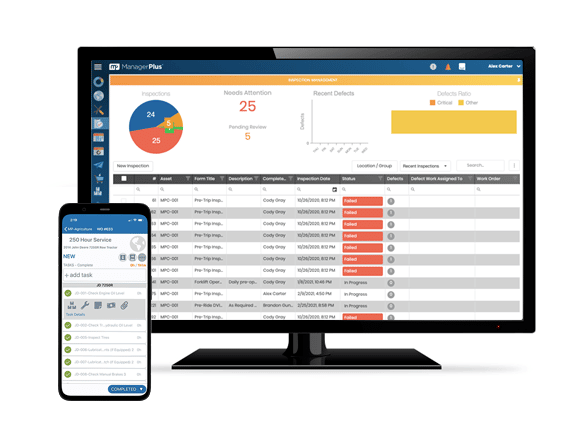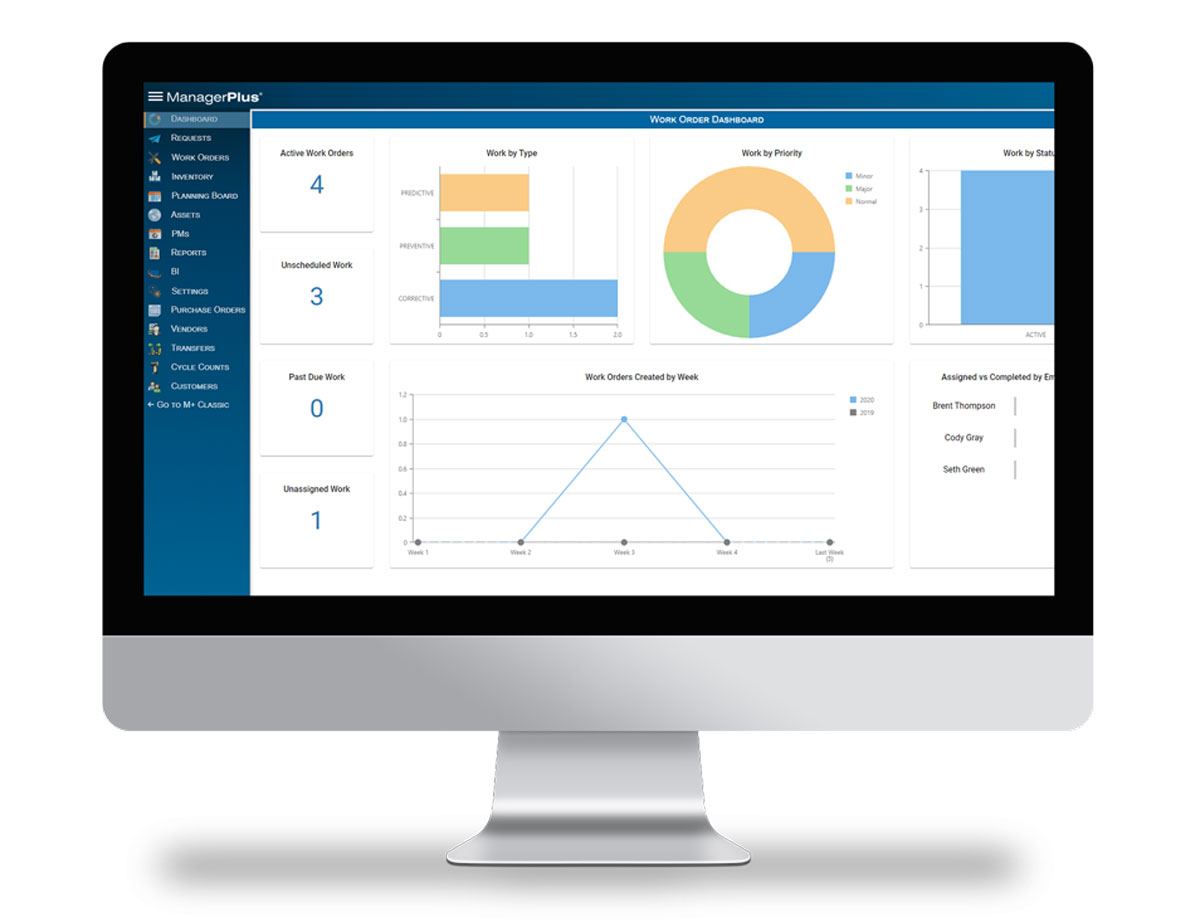Managing assets effectively requires a strong maintenance program.
Preventive maintenance has long been established as the best way to maintain assets, but the advent of connected technology has given rise to a new form of asset maintenance – predictive maintenance.But before we dive into the differences between preventive and predictive maintenance, let’s look at the four main maintenance strategies to get our bearings.
What are the different types of maintenance?
When it comes to maintenance programs for manufacturing equipment, fleet, or any other type of heavy machinery that needs, there are four basic strategies.
- Reactive (Run-to-failure)
- Condition-based
- Preventive
- Predictive
Each one has its pros and cons, and because different assets may require different types of maintenance, most companies implement a combination of strategies for their assets.
What is reactive maintenance?
Reactive maintenance, sometimes also known as corrective or run-to-failure (RTF) maintenance, is essentially letting the asset operate normally until something on it breaks and needs to be repaired.
Side note: true RTF maintenance involves running the asset until the entire piece of equipment fails and needs to be replaced, i.e., lightbulbs.
Reactive maintenance is the easiest maintenance strategy to implement, but it is really only cost-effective for a few types of assets. For larger, more complex assets, using only a reactive maintenance strategy ends up being much more expensive in the long run.
What is condition-based maintenance?
This is when you monitor an asset as it performs, and once it drops below a certain level of production, you repair or replace it. Often this is done based on manufacturer recommendations or by observing the asset and using knowledge of the equipment to know when you perform maintenance.
A good example of condition-based maintenance is tires on a work truck. While sometimes replaced after a certain number of miles, depending on the type of terrain the trucks are driving on, it’s usually best to just keep an eye on the tires, and when the tread reaches a certain level, replace the tires.
What is preventive maintenance (PM)?
Preventive maintenance is quickly becoming the most widely used strategy and has long been the most recommended. This is due to the incredible amount of cost savings that can be found using preventive maintenance.
Preventive maintenance is the practice of scheduling maintenance activities at regular intervals according to pre-determined metrics to prevent equipment failures.
Much like the oil on a truck needs to be replaced every few thousand miles or gears on a machine need to be lubricated after so many cycles, preventive maintenance plans out the maintenance work ahead of time so you’re not waiting until after something breaks to fix it.
What is predictive maintenance (PdM)?
Predictive maintenance is the most expensive and resource-intensive maintenance program available but can also save your company more money in the long run than any other maintenance strategy.
This involves placing sensors on your assets to constantly monitor their performance and then using software to anticipate when parts of the equipment might break.
The biggest downside of predictive maintenance is the enormous up-front investment and training it requires to implement properly.

What’s the difference between preventive and predictive maintenance (PM vs PdM)?
Preventive maintenance and predictive maintenance are the most recommended and are quickly becoming the most common maintenance strategies across the asset management industry.
Why preventive maintenance is a good investment
We’ve already established that preventive maintenance is the most widely recommended maintenance strategy for a number of reasons. And while it does have some similarities to predictive maintenance, there are some key differences.
The main aspect of preventive maintenance is that it’s scheduled – it occurs at regular, pre-determined intervals. The maintenance can be scheduled and take place whether or not the equipment actually needs to repair to continue functioning.
Changing the oil on a work truck is a good example. Best practices dictate the oil should be changed every few thousand miles, but technically, the vehicle could continue to run efficiently if the oil doesn’t get changed at that specific interval. It could go another few hundred, or possibly thousand miles before it fails.
We use a specific interval because without having an expensive, highly tuned sensor in the engine collecting real-time data, that interval, based on past experience, gives us the best chance of preventing an engine failure.
Think about it this way: the main idea behind preventive maintenance is to take regular steps to prevent problems.
There are some main characteristics of preventive maintenance:
- It is scheduled at regular, pre-determined intervals
- It generally requires the machine to be offline
- It often requires a checklist including inspection, calibration, cleaning, repair, and replacement
- The intervals may be different depending on the maintenance performed (cleaning vs. inspection)
- It occurs even if an issue has not been detected
Preventive maintenance doesn’t always include repairs. A large part of preventive maintenance is performing regular inspections to ensure equipment is working as expected. Just because you check the oil in your car doesn’t mean it’s time to replace it. But if you hadn’t checked, you wouldn’t know.
The biggest benefit of preventive maintenance is the return on investment. The costs of implementing a preventive maintenance program, including a computerized maintenance management system (CMMS) or enterprise asset management (EAM) software to facilitate it, are fairly small compared to the amount you can save by switching from reactive maintenance. One of the disadvantages of preventive maintenance is that you may be addressing issues that don’t exist. Preventive maintenance activities are performed on a schedule, not necessarily at the exact time that the equipment needs it.
One of the disadvantages of preventive maintenance is that you may be addressing issues that don’t exist. Preventive maintenance activities are performed on a schedule, not necessarily at the exact time that the equipment needs it.
Going back to the vehicle oil, say you replace it at 6,000 miles, but an engine failure may not have happened until 7,500 miles. Sure, you kept the engine from failing, but you technically performed the repair earlier than you needed too meaning you incurred more inventory, labor, and downtime costs than you had to.
Why predictive maintenance is a good investment
Predictive maintenance has become possible due to Industry 4.0 through the connected Internet of Things (IoT). The IoT is the idea that data is king, and the more data you have on your equipment, the better informed decisions your can make.
Like preventive maintenance, predictive maintenance is a proactive approach. It involves installing highly tuned sensors onto your equipment that continuously monitors its condition and predicts when something on the equipment might break, prompting a repair.
Preventive maintenance relies more on best practices and recommendations while predictive maintenance gathers real-time data and indicates when a problem may occur, allowing you time to schedule critical maintenance work well in advance of a failure.
Predictive maintenance:
- Is proactive
- Can often be performed without needing a shutdown
- Identifies potential problems allowing maintenance to take place before a failure
- Relies on large amounts of data collected from specialized equipment
- Requires tools and trained personnel to analyze equipment data
The cost savings of predictive maintenance are potentially enormous. McKinsey Global Institute predicting predictive maintenance could save the manufacturing industry between $240-$627 billion. With all this data being collected in real-time, you will always know exactly when to repair your assets.
Predictive maintenance will always provide the most granular approach and will give you the data you need to make informed decisions about your assets. When you can see exactly how much your assets are costing to maintain, you can better decide when it’s time to upgrade or replace them.
The biggest disadvantage to predictive maintenance is the high initial costs to get it up and running. With things like sensors, software, training, and potentially even extra personnel, predictive maintenance requires a sizeable investment.
Which one do I need?
It really all depends on the financial goals and flexibility of your organization.
While predictive maintenance is the most high-tech and data-rich maintenance program available, it doesn’t make sense for every company. If you have a large number of very expensive, highly complex machines across multiple sites and a large enough budget to accommodate it, then predictive maintenance is the best choice. It will give you up-to-the-minute performance data on all of your assets and will keep your maintenance team out in front of repairs to eliminate unplanned downtime and reduce asset failures.
For most organizations, preventive maintenance is the best way to go. It has a much lower investment cost, can be up and running quickly, and doesn’t require a lot of extra training to be effective. Plus, it can save you up to 18% on your maintenance costs.
Preventive maintenance is the go-to maintenance program in the asset management industry for reducing unplanned downtime and moving maintenance teams off of reactive maintenance. It is also proven to increase the life of your assets, and the low barrier to entry makes it accessible to any sized organization. It can be implemented for one large asset like a machine press, or several smaller assets like a fleet of vehicles.
How do I get started?
To run a preventive maintenance program effectively, you’ll need an EAM software solution. ManagerPlus Lightning from iOFFICE is a robust, cloud-based EAM that gives you all the tools you need to develop, implement, and manage a preventive maintenance program effectively.
Everything from work orders to inventory management to vendor communication can all be managed from within our always-connected, mobile-friendly software. You can also generate reports that will show you exactly how your maintenance budget is being spent and help you find gaps in your operations.
Did I miss anything?
Preventive maintenance and predictive maintenance are the two most cost-effective maintenance strategies available. Both provide a significant return on investment and while both have similar outcomes, they have some key differences.
Preventive maintenance:
- Happens at pre-determined, regularly scheduled intervals
- Occurs even if an issue has not been detected
- Has a relatively low startup cost
Predictive maintenance:
- Gathers large amounts of data to recommend maintenance work before problems occur
- Requires specialized equipment and training
- Requires a large upfront investment
Unless you have multiple large, highly complex assets spread across multiple sites and a large maintenance budget, preventive maintenance is the better option for most organizations.
ManagerPlus Lightning can help you implement and monitor your preventive maintenance strategy. Schedule a live demo to see it in action.



